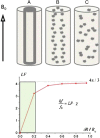Biophysical mechanisms of MRI signal frequency contrast in multiple sclerosis
- PMID: 22891307
- PMCID: PMC3435153
- DOI: 10.1073/pnas.1206037109
Biophysical mechanisms of MRI signal frequency contrast in multiple sclerosis
Abstract
Phase images obtained with gradient echo MRI provide image contrast distinct from T1- and T2-weighted images. It is commonly assumed that the local contribution to MRI signal phase directly relates to local bulk tissue magnetic susceptibility. Here, we use Maxwell's equations and Monte Carlo simulations to provide theoretical background to the hypothesis that the local contribution to MRI signal phase does not depend on tissue bulk magnetic susceptibility but tissue magnetic architecture--distribution of magnetic susceptibility inclusions (lipids, proteins, iron, etc.) at the cellular and subcellular levels. Specifically, we show that the regular longitudinal structures forming cylindrical axons (myelin sheaths and neurofilaments) can be locally invisible in phase images. Contrary to an expectation that the phase contrast in multiple sclerosis lesions should always increase in degree along with worsening of lesion severity (which happens for all known MR magnitude-based contrast mechanisms), we show that phase contrast can actually disappear with extreme tissue destruction. We also show that the phase contrast in multiple sclerosis lesions could be altered without loss of nervous system tissue, which happens in mild injury to the myelin sheaths or axonal neurofilaments. Moreover, we predict that the sign of phase contrast in multiple sclerosis lesions indicates the predominant type of tissue injury-myelin damage (positive sign) vs. axonal neurofilament damage (negative sign). Therefore, our theoretical and experimental results shed light on understanding the relationship between gradient echo MRI signal phase and multiple sclerosis pathology.
Conflict of interest statement
Conflict of interest statement: A.H.C. was a consultant for Teva Pharmaceutical Industries Ltd., Biogen Idec Inc., F. Hoffmann–La Roche Ltd., MedImmune, and Coronado Biosciences. A.H.C. also discloses support from Novartis Research, F. Hoffmann–La Roche Ltd Research, and the Sanofi-aventis Group.
Figures





Similar articles
-
Correlating new directional measures of myelin and axonal integrity in T2-weighted MRI with quantitative histology in multiple sclerosis.J Neurosci Methods. 2019 Jan 1;311:369-376. doi: 10.1016/j.jneumeth.2018.09.020. Epub 2018 Sep 19. J Neurosci Methods. 2019. PMID: 30240805
-
Imaging correlates of axonal swelling in chronic multiple sclerosis brains.Ann Neurol. 2007 Sep;62(3):219-28. doi: 10.1002/ana.21113. Ann Neurol. 2007. PMID: 17427920
-
Tracking iron in multiple sclerosis: a combined imaging and histopathological study at 7 Tesla.Brain. 2011 Dec;134(Pt 12):3602-15. doi: 10.1093/brain/awr278. Brain. 2011. PMID: 22171355 Free PMC article.
-
Non-conventional MRI techniques for measuring neuroprotection, repair and plasticity in multiple sclerosis.Curr Opin Neurol. 2008 Jun;21(3):272-7. doi: 10.1097/WCO.0b013e328300525b. Curr Opin Neurol. 2008. PMID: 18451709 Review.
-
The role of magnetic resonance techniques in understanding and managing multiple sclerosis.Brain. 1998 Jan;121 ( Pt 1):3-24. doi: 10.1093/brain/121.1.3. Brain. 1998. PMID: 9549485 Review.
Cited by
-
Evaluation of the Blood-Brain Barrier, Demyelination, and Neurodegeneration in Paramagnetic Rim Lesions in Multiple Sclerosis on 7 Tesla MRI.J Magn Reson Imaging. 2024 Mar;59(3):941-951. doi: 10.1002/jmri.28847. Epub 2023 Jun 5. J Magn Reson Imaging. 2024. PMID: 37276054 Free PMC article.
-
Seven-tesla phase imaging of acute multiple sclerosis lesions: a new window into the inflammatory process.Ann Neurol. 2013 Nov;74(5):669-78. doi: 10.1002/ana.23959. Epub 2013 Sep 16. Ann Neurol. 2013. PMID: 23813441 Free PMC article.
-
A comparison of phase imaging and quantitative susceptibility mapping in the imaging of multiple sclerosis lesions at ultrahigh field.MAGMA. 2016 Jun;29(3):543-57. doi: 10.1007/s10334-016-0560-5. Epub 2016 Apr 25. MAGMA. 2016. PMID: 27112155 Free PMC article.
-
Reduced accuracy of MRI deep grey matter segmentation in multiple sclerosis: an evaluation of four automated methods against manual reference segmentations in a multi-center cohort.J Neurol. 2020 Dec;267(12):3541-3554. doi: 10.1007/s00415-020-10023-1. Epub 2020 Jul 3. J Neurol. 2020. PMID: 32621103 Free PMC article.
-
Subcomponents of brain T2* relaxation in schizophrenia, bipolar disorder and siblings: A Gradient Echo Plural Contrast Imaging (GEPCI) study.Schizophr Res. 2015 Dec;169(1-3):36-45. doi: 10.1016/j.schres.2015.10.004. Epub 2015 Oct 23. Schizophr Res. 2015. PMID: 26603058 Free PMC article.
References
-
- Abduljalil AM, Schmalbrock P, Novak V, Chakeres DW. Enhanced gray and white matter contrast of phase susceptibility-weighted images in ultra-high-field magnetic resonance imaging. J Magn Reson Imaging. 2003;18:284–290. - PubMed
-
- Zhong K, Leupold J, von Elverfeldt D, Speck O. The molecular basis for gray and white matter contrast in phase imaging. Neuroimage. 2008;40:1561–1566. - PubMed
-
- Marques JP, Maddage R, Mlynarik V, Gruetter R. On the origin of the MR image phase contrast: An in vivo MR microscopy study of the rat brain at 14.1 T. Neuroimage. 2009;46:345–352. - PubMed
Publication types
MeSH terms
Substances
Grants and funding
LinkOut - more resources
Full Text Sources
Other Literature Sources
Medical

